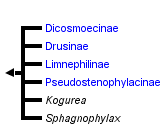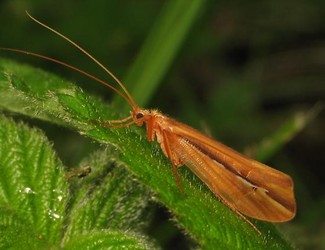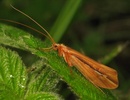Limnephilidae
Ralph W. Holzenthal, Roger J. Blahnik, Aysha Prather, and Karl Kjer


This tree diagram shows the relationships between several groups of organisms.
The root of the current tree connects the organisms featured in this tree to their containing group and the rest of the Tree of Life. The basal branching point in the tree represents the ancestor of the other groups in the tree. This ancestor diversified over time into several descendent subgroups, which are represented as internal nodes and terminal taxa to the right.

You can click on the root to travel down the Tree of Life all the way to the root of all Life, and you can click on the names of descendent subgroups to travel up the Tree of Life all the way to individual species.
For more information on ToL tree formatting, please see Interpreting the Tree or Classification. To learn more about phylogenetic trees, please visit our Phylogenetic Biology pages.
close boxIntroduction
This is the largest family in the Plenitentoria, with approximately 900 described species. At higher latitudes and elevations, it is the dominant group in much of the Northern Hemisphere. The family was first established by Kolenati (1848) and includes species described by Linnaeus in Systema Naturae, 10th ed. Schmid (1955) resolved the family into its current classification, with refinements by Wiggins and colleagues (Vineyard & Wiggins 1988, Wiggins 1973, Wiggins et al. 1985). The Dicosmoecinae include the only Southern Hemisphere taxa in the family.
This is arguably the most ecologically diverse caddisfly family, as larvae occupy the full range of habitats. Limnephilid larvae are found in lakes, streams, and marshes. Some species of Ironoquia live in temporary pools and streams. Desmona larvae have been observed leaving the water at night to feed on shoreline plants (Erman 1981, Wiggins & Wisseman 1990), and a North American species of Philocasca Ross has an entirely terrestrial larva. Limnephilid larvae use both plant and mineral materials in their cases; the general trend in the family is that larvae in cool running waters use rock material, while those in warmer lentic habitats use plant material (Wiggins 1996).
Discussion of Phylogenetic Relationships
The monophyly of Limnephilidae is supported by multiple independent genes, including nuclear rRNA, and mitochondrial COI (Kjer et al., 2001), as well as combined molecular data, and combined molecular and morphological data (Kjer et al., 2001; 2002; Holzenthal et al., 2007).References
Erman, N.A. (1981) Terrestrial feeding migration and life-history of the stream dwelling caddisfly, Desmona bethula (Trichoptera: Limnephilidae). Canadian Journal of Zoology, 59, 1658–1665.
Holzenthal et al., 2007 R.W. Holzenthal, R.J. Blahnik, A.L. Prather and K.M. Kjer, Order Trichoptera Kirby, 1813 (Insecta), caddisfles, Zootaxa 1668 (2007), pp. 639–698.
Kolenati, F.A. (1848) Genera et species Trichopterorum. Pars prior. Acta Regiae Bohemoslovenicae Societatis Scientiarum, Prague, 6, 1–108.
Schmid, F. (1955) Contribution a l'etude des Limnophilidae (Trichoptera). Mitteilungen der Schweizerischen Entomologischen Gesellschaft, 28 beiheft, 1–245.
Vineyard, R.N. & Wiggins, G.B. (1988) Further revision of the caddisfly family Uenoidae (Trichoptera): evidence for inclusion of Neophylacinae and Thremmatidae. Systematic Entomology, 13, 361–372.
Wiggins, G.B. (1973) Contributions to the systematics of the caddisfly family Limnephilidae (Trichoptera). I. Life Science Contributions, Royal Ontario Museum, 94, 1–32.
Wiggins, G.B. (1996) Larvae of the North American Caddisfly Genera (Trichoptera). University of Toronto Press, Toronto, 457 pp.
Wiggins, G.B., Weaver, J.S., III & Unzicker, J.D. (1985) Revision of the caddisfly family Uenoidae (Trichoptera). Canadian Entomologist, 117, 763–800.
Wiggins, G.B. & Wisseman, R.W. (1990) Revision of the North American caddisfly genus Desmona (Trichoptera: Limnephilidae). Annals of the Entomological Society of America, 83, 155–161.
Title Illustrations

| Scientific Name | Psychoglypha sp. |
|---|---|
| Location | Port Coquitlam, Lower Mainland, British Columbia, Canada |
| Specimen Condition | Live Specimen |
| Size | 12mm excluding ant. |
| Source | caddis - Psychoglypha |
| Source Collection | BugGuide.Net |
| Image Use |
 This media file is licensed under the Creative Commons Attribution-NonCommercial-NoDerivs License - Version 1.0. This media file is licensed under the Creative Commons Attribution-NonCommercial-NoDerivs License - Version 1.0.
|
| Copyright | © 2007 Sean McCann |
About This Page
Ralph W. Holzenthal

University of Minnesota, St. Paul, Minnesota, USA
Roger J. Blahnik

University of Minnesota, St. Paul, Minnesota, USA
Aysha Prather

Centre for Biodiversity and Conservation Biology, Royal Ontario Museum, Toronto, Ontario, Canada
Karl Kjer

Rutgers University, New Brunswick, New Jersey, USA
Correspondence regarding this page should be directed to Ralph W. Holzenthal at , Roger J. Blahnik at , Aysha Prather at , and Karl Kjer at
Page copyright © 2010 Ralph W. Holzenthal, Roger J. Blahnik, Aysha Prather, and Karl Kjer
 Page: Tree of Life
Limnephilidae.
Authored by
Ralph W. Holzenthal, Roger J. Blahnik, Aysha Prather, and Karl Kjer.
The TEXT of this page is licensed under the
Creative Commons Attribution-NonCommercial-ShareAlike License - Version 3.0. Note that images and other media
featured on this page are each governed by their own license, and they may or may not be available
for reuse. Click on an image or a media link to access the media data window, which provides the
relevant licensing information. For the general terms and conditions of ToL material reuse and
redistribution, please see the Tree of Life Copyright
Policies.
Page: Tree of Life
Limnephilidae.
Authored by
Ralph W. Holzenthal, Roger J. Blahnik, Aysha Prather, and Karl Kjer.
The TEXT of this page is licensed under the
Creative Commons Attribution-NonCommercial-ShareAlike License - Version 3.0. Note that images and other media
featured on this page are each governed by their own license, and they may or may not be available
for reuse. Click on an image or a media link to access the media data window, which provides the
relevant licensing information. For the general terms and conditions of ToL material reuse and
redistribution, please see the Tree of Life Copyright
Policies.
- First online 17 July 2010
- Content changed 20 July 2010
Citing this page:
Holzenthal, Ralph W., Roger J. Blahnik, Aysha Prather, and Karl Kjer. 2010. Limnephilidae. Version 20 July 2010 (under construction). http://tolweb.org/Limnephilidae/14615/2010.07.20 in The Tree of Life Web Project, http://tolweb.org/







 Go to quick links
Go to quick search
Go to navigation for this section of the ToL site
Go to detailed links for the ToL site
Go to quick links
Go to quick search
Go to navigation for this section of the ToL site
Go to detailed links for the ToL site